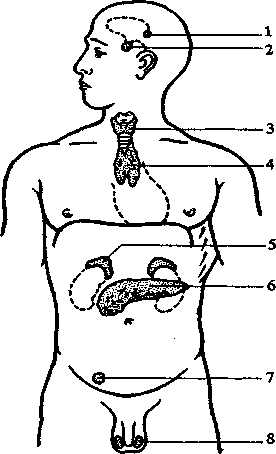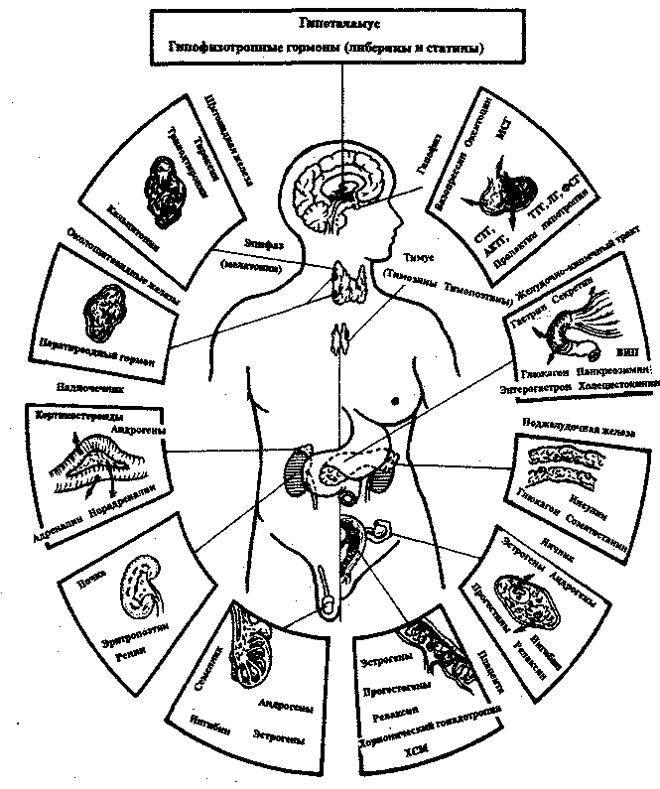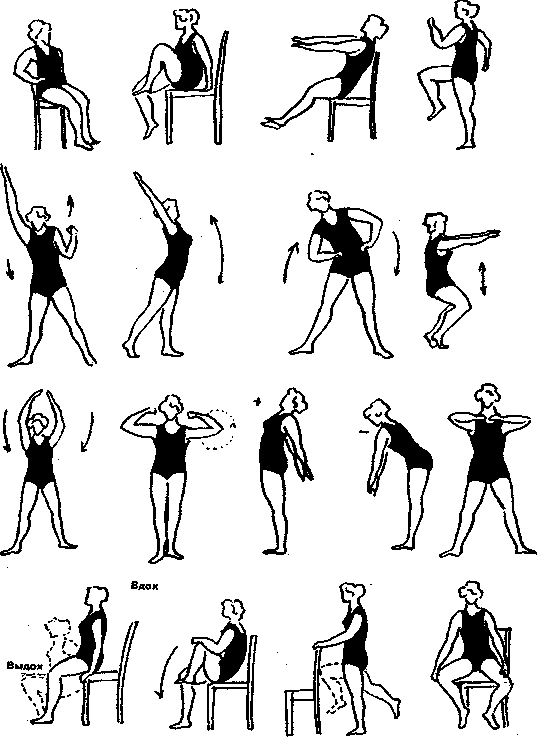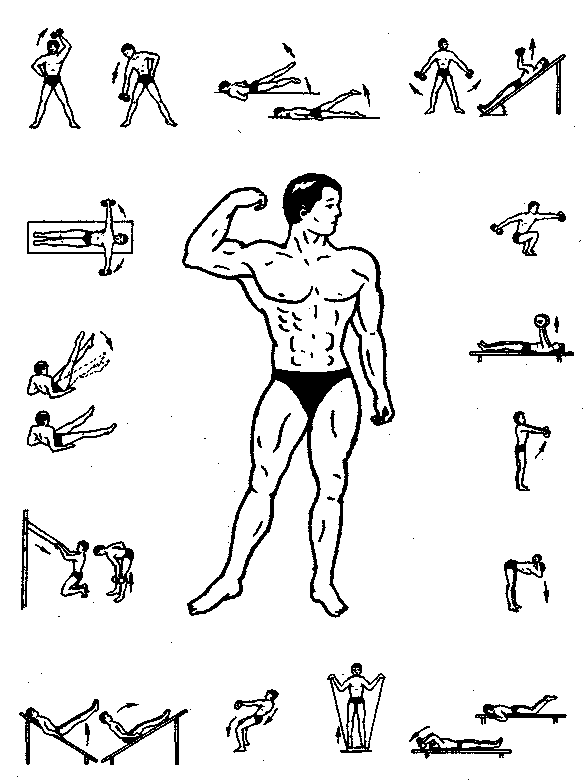KINESITHERAPY AT endocrine glands and metabolic disturbance
Go to the endocrine glands include the thyroid, parathyroid, pituitary, pineal, thymus, adrenal and some other (Fig. 91). Gland function is in the production of hormones that stimulate or conversely, inhibit the development and vitality of individual organs and body as a whole. Hormones normally produced in small quantities and with blood carried to the destination.

Fig. 91. Ductless glands (scheme): 1 - epiphysis, 2 - pituitary gland;
3 - Thyroid 4 - thymus gland, 5 - adrenal, 6 - pancreas; 7 - the ovaries, 8 - seed
Endocrine glands are an integral part of the system of neurohumoral regulation of body functions (Fig. 92). They produce hormones play a role of chemical regulators of metabolism in tissues. Signal to the excitation of hormone secretion usually comes from sensory nerve endings - Exter or interoreceptors - and afferent nerve paths enters the CNS, in the hypothalamic region.

Fig. 92. The most important endocrine glands and the hormones secreted by them:
ACTH - adrenocorticotropic hormone; VIP - vasoactive intestinal peptide; LH - luteinizing hormone, MSH - melanocyte stimulating hormone, growth hormone - STH (growth) hormone, TSH - thyroid stimulating hormone, FSH - follicle-stimulating hormone; High School Musical - chorionic somatomammotropin
Here are concentrated nerve nuclei that control autonomic nervous system. Processes of afferent synthesis give rise to excitation in the neurons mentioned nuclei.
Emanating from these impulses reach the cells of the endocrine glands in different ways. Some cancer (eg, adrenal medulla) receive abundant innervation, and regulation of their activity is carried out almost exclusively by the nerve. Other glands are excited by humoral stimuli emanating from the central endocrine glands - pituitary gland - in the form of its triple hormones.
Normal course of metabolic processes in the body both at rest and in a changing external environment provides a full activity of the endocrine system. Violation of hormone leads to metabolic disorders and functions of internal organs, and later - to the organic their defeat. Therefore, endocrine disease accompanied by symptoms of disorders of various internal organs.
Diseases of the endocrine glands can occur with symptoms of excess or lack of function.
Glands osuscheetvlyayut chemical regulation in the body, and their condition can occur various disorders for almost all functions of the human body (the development and growth, metabolism, CNS excitability, muscle tone, function of internal organs, etc.).
Exercise had a significant effect on metabolism. This explains the widespread use of exercise function in disorders of the endocrine glands.
Metabolic disorders (obesity, gout, diabetes) should not be regarded as isolated violations of any part of metabolism (carbohydrate, fat, purine, and others), but as a condition for which there are various combinations of disorders nervnotroficheskoy and hormonal regulation of metabolism organism.
With obesity, for example, violated not only the fat metabolism. Important is the inability of the liver and muscle glycogen to delay. And then the carbohydrates turn to fat.
In diabetes, disrupted water and fat metabolism, as in gout, along with changes in purine metabolism distorted fat (obesity) and carbohydrate (diabetes) exchanges.
In the prevention of these disorders attach great importance to nutrition and moderate exercise, which affect metabolism through activation of neural and humoral factors.
In order to restore disturbed functions of the body and individual organs injected hormones, obtained by extraction of the glands (so-called replacement therapy).
Diabetes mellitus
Diabetes - a disease caused by absolute or relative deficiency of insulin in the body and is characterized by gross violations of carbohydrate metabolism, with hyperglycemia and glucosuria (sugar urine "), as well as other metabolic disorders.
One of the causative factors is the hereditary predisposition, and obesity, Arteriosclerosis of the pancreas, physical and mental trauma, infection, excessive use of carbohydrates, etc.
Lack of insulin in the body leads to a violation of carbohydrate, fat and protein metabolism. Decreases the permeability of cell membranes for glucose in adipose and muscle tissue, enhanced glycogenolysis and gluconeogenesis, hyperglycemia and glucosuria appear, accompanied by polyuria and polydipsia. Reduced formation and increased breakdown of fats, which leads to an increase in blood levels of ketone bodies. This causes a shift of acid-base balance towards acidosis contributes to increased excretion of potassium ions, sodium and magnesium in the urine, breaks the kidney function.
The increased flow of nonesterified fatty acids in the liver as a result of lipolysis leads to rapid formation of triglycerides. There has also been enhanced synthesis of cholesterol. Reduced protein synthesis, including antibodies, which leads to a decrease in resistance to infection. Defective protein synthesis is the cause of dysproteinemia (decrease of albumin fraction and an increase in alpha-globulin). Significant loss of fluid due to polyuria lead to dehydration. Increasing the allocation from the body as chlorides, nitrogen, phosphorus and calcium.
There are three stages in the development of diabetes: prospective diabetes when there are only predisposed to the disease, latent diabetes, which is detected by tests for tolerance to carbohydrates; explicit diabetes when there are characteristic clinical and biochemical symptoms of the disease. Patients concerned about dry mouth, polyuria, weight loss, weakness, reduced disability, increased appetite, itchy skin and itchy in the crotch, pyoderma, fungal skin lesions, etc. The blood is determined by the heightened level of sugar in the urine - glycosuria.
Depending on the level of glucose, sensitivity to treatment effects and the presence or absence of complications are three degrees of severity of diabetes:
mild when the blood sugar level does not rise above 1.6 g / l (160 mg%), ketoacidosis is missing, the compensation is achieved by diet;
moderate to severe degree (there is a tendency to ketoacidosis);
severe, when the fluctuations in blood sugar during the day more than 2-2,5 g / l, are prone to hypoglycemia, ketoacidosis.
Unfortunately, in recent years significantly increased the incidence of diabetes and the number of deaths associated with its consequences.
It is known that diabetes is an incurable disease and occurs at any age. Overeating, mental strain, lack of physical activity significantly increases the number of patients with diabetes.
To identify diabetes need for a massive check-ups.
Rehabilitation of patients with diabetes: diet therapy, oral hypoglycemic agents and insulin. The basic principle of the diet - individual selection of daily calories, with the exception carbohydrate; split meals (4-5 times a day). Should restrict or eliminate refined carbohydrates from foods. However, the total amount of carbohydrate should be no less than 125 grams per day to prevent ketoacidosis.
Used as massage, exercise therapy, dosed walking, walking skiing, swimming, etc. The main thing - to prevent fatigue.
MH (Fig. 93) includes a General developing, breathing and relaxation exercises, lying down, sitting and standing. It is also recommended exercises with gymnastic stick, padded balls, playing exercises. The pace is slow and average.
Massage technique. Massages the neck area, back (reflex zones), lower limbs, thorax and abdomen. If you have dry skin massage is carried out with oil (eucalyptus, fir, or sunflower). Duration of the massage for 10-15 minutes, the course of 10-20 procedures per year 3-4 courses.
Obesity
Obesity - weight gain due to excess deposition of adipose tissue. There is an exogenous-constitutional obesity due to discrepancies between income and expenditure of energy in the presence of a constitutional predisposition; cerebral obesity-related brain disease (inflammation, trauma, tumor); endocrine obesity, occurs when the pathology of the endocrine system (pituitary disease, adrenal gland, thyroid gland etc.).
There are three degrees of obesity: I degree - an excess of body weight by 30%; II degree - an excess of body weight by 30-49%; III degree - an excess of body weight by 50% and above. More pronounced degree (II-III) is observed with cerebral obesity. Patients complain of shortness of breath on exertion, fatigue, sleepiness, increased appetite and thirst. Perhaps the development of chronic respiratory failure and pulmonary hypertension.
Rehabilitation with exogenous constitutional obesity: the appointment of a diet (restriction of total calories, fluids, salt, split meals) 1-2 times a week fasting days (eg, 1-2 liters of yogurt per day or 1.5 kg of apples), sauna and receive a warm shower, physical activity (exercise therapy, dosed walking on rough terrain, swimming, skiing, gaming and other forms of physical activity), vibrating massage (followed by wiping the entire body with alcohol) of vitamin complexes, and diuretics (1 -2 times a week) with preparations of potassium; hypoglycemic agents (biguanides), herbal laxatives.

Fig. 93. Approximate complex N Diabetes
94 shows an exemplary set of exercises with dumbbells, rubber bands, balls and a padded gym wall. After the class is useful massage your feet back muscles, buttocks and legs.
Massage for obesity used in conjunction with exercise and gym, as well as in the bath (sauna) for increasing the metabolism. Obese should remember that after a workout, the sauna (bath) for the loss of mass (weight) of the body should not swim in cold water and take a cold shower, because they cause spasm of the capillaries, and excretion of fluids (sweat) inhibited.

Fig. 94. Примерный комплекс ЛГ при ожирении 94. Approximate complex LH in obese
In obesity is most effective vibration, vacuum and hydro-massage. A course of 15-20 procedures in conjunction with exercise, diet and half-board sauna (bath) in a week.
Gout
Gout - a disease characterized by a violation of purine metabolism and is accompanied by accumulation of uric acid in the body. Characteristic manifestation of the disease - relapsing arthritis. Usually there are recurrent acute mono-or oligoarticular form joints of lower limbs, with frequent involvement of the 1 st metatarzofalangovogo joint (approximately 75% of patients), joints, metatarsus, ankle and knee joints.
Gouty arthritis has characteristic features: it often expresses itself at night, pain intensity increases very rapidly and in a few hours reaches a maximum. The pain is usually a very strong movement in the joint becomes impossible, there is periarticular swelling, redness under the joint. In some cases there is a chronic polyarthritis with periodic amplification and attenuation of inflammation.
Gout is often combined with other forms of violation of the exchange - obesity and diabetes. Gout in the attachment to bone ligaments, joint capsules, tendons, bone growths develop - osteophytes. Often there is a deformity of the joints.
Treatment. Drug therapy, excessive drinking, diet (exclude meat, kidney, liver, beans, etc.), sauna (bath), full body massage and exercise therapy. With spa treatment recommended swimming, cycling, oxygen cocktail receptions, massage, medical gymnastics.
The complex consists of the General developing gymnastics exercises and breathing exercises, exercises with balls, gymnastic stick lying, sitting and doing exercises in water (bath, pool) with sauna (bath).
The problem of massage: the normalization of metabolic processes, the removal (decrease) in pain, improvement of metabolic tissues, their trophic. Prevention of acute gouty attacks.
Massage technique. Initially held massage the lumbar region, buttocks, lower limbs, and then the joints (the most frequent localization of pain in the metatarsal-phalanx joints). Massage joints sparing (stroking and active-passive movement). Duration of the massage for 8-10 minutes. Course of 10-15 procedures.
In the complex treatment of gout (diet, exercise therapy, walking, etc.) shows salt foot bath.
Edema disease
Malnutrition - eating disorders, caused by inadequate intake of protein, fat and carbohydrates. In the development of dystrophy significant role played by neuro-mental fatigue, prolonged physical fatigue (surge), stay in conditions of low temperature, severe febrile and toxic diseases, etc.
Malnutrition can occur with a predominant deficiency of energy (fats, carbohydrates) or plastic (proteins) resources. With a total of malnutrition initially depleted energy materials, and then plastic. Decreasing the basic structure of tissues (going to atrophy).
There are three stages (degree) malnutrition: I stage is characterized by the depletion of energy resources; III stage is characterized by a decrease in protein cellular and tissue structures; stage is characterized by the development of far come to a considerable extent irreversible, changes in the body, leading to a state of cachexia with the decline of the functions of all organs.
Comprehensive rehabilitation includes diet, exercise therapy, massage, gidroprotsedury, sauna and other methods. For the treatment of stage I or II should receive increased fractional power (6-8 times a day), providing sufficient calorie food and the necessary number of animal proteins, fats and carbohydrates, and vitamins. Important is the acceptance of animal protein (meat, cheese, fish, etc.), and for stage III - a fractional power, in a powdered form of porridge in a shabby, vegetables in the form of puree, juices, soups, mucous, as well as intravenous administration of proteins, fats and vitamins. Fractional, plentiful drink.
Massage done with heated massage oil; binding PH, swimming, and in future - training on simulators (exercise bike, treadmill, etc.), as well as a contrast shower, sauna (bath), massage brush in the bath, etc.
In severe forms of dystrophy patient treatment: prescribe intravenous glucose, blood transfusion, amino acids, a fraction, frequent (6-8 times a day) diet, with severe dehydration injected with saline; include massage, body rubbing alcohol solution; LH lying and sitting ( General developing and breathing exercises). Once the patient begins to walk, he appointed gidrokinezoterapiyu, vibrating massage needle vibratodami (especially paravertebral zones and stop). MH is best done accompanied by music.
Myxedema (hypothyroidism)
Hypothyroidism - a disease characterized by low thyroid function. In primary hypothyroidism, the pathological process directly affects the thyroid gland, secondary hypothyroidism occurs as a result of the defeat of the hypothalamic-pituitary system.
Characteristic of the disease are: coldness, weakness, drowsiness, constipation, dry skin, brittle and hair loss, etc. There is slow motion, swelling of subcutaneous fat face, extremities, bradycardia, dull heart sounds, etc. Decreased basal metabolic rate, frequently develop iron deficiency hypochromic anemia, etc.
Conservative treatments include drug therapy (replacement therapy with thyroid hormones - tireodin, triiodothyronine, and others), vitamins A, C, B; exercise therapy, massage, walking, biking, skiing, etc.
Dispituitarizm Youth
Dispituitarizm Youth - adolescence and youth dysfunction of the hypothalamic-pituitary system to increase the secretion of growth hormone and adrenocorticotropic hormone, as well as violation of secretion of thyrotropin and gonadotropins. Dispituitarizm occurs after trauma, infection, a sharp decrease in physical activity, cessation of systematic exercise, obesity in early childhood, etc. Against this background, age physiological activation of the neuroendocrine system leads to its dysfunction.
Observed dispituitarizm aged 12-23 years. For this disease is characterized by tall (often boys), even obesity, increased breast cancer in men and menstrual disorders in girls, have often been observed transient hypertension (mostly boys).
Conservative treatment dispituitarizma: a diet with reduced calorie, 2-3 times a week "fasting days"; diuretics, thyroid medications, physical activity (walking, jogging), horse-country skiing, cycling, training on simulators, sauna (bath) , swimming ..
Treatment of juvenile forms of obesity is prevention of diabetes, hypertension, infertility.
